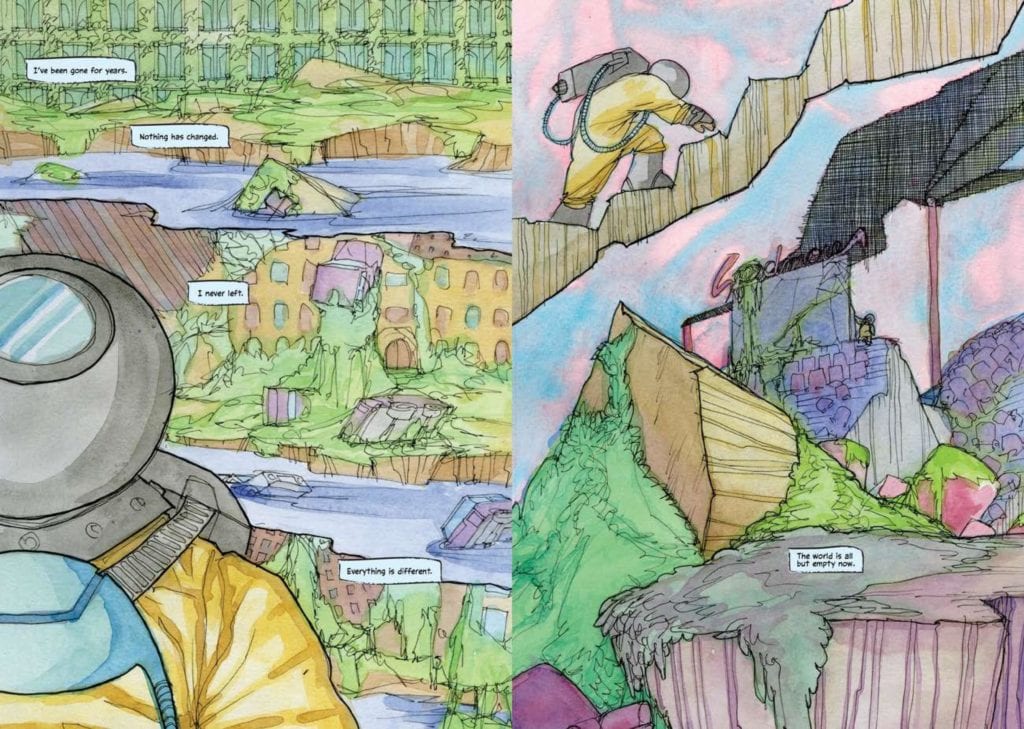A Radical Shift of Gravity trade paperback hits your local comic book shop on June 24, but thanks to IDW Publishing, Monkeys Fighting Robots has an exclusive interview with writer Nick Tapalansky and artist Kate Glasheen.
About the book:
The world is changing. Gravity, a force everyone takes for granted, has begun to disappear. As a young journalist, Noah spends his days documenting the wondrous and terrifying shifts in the world around him. But Noah’s life is changing, too. Falling in love and raising a rebellious daughter adds new meaning to life in this mysterious floating world. As he covers the invention of new sports, interviews experts, and even journeys into space, each experience shapes how Noah views the world and, in turn, his relationship with his family. And as his daughter grows older, Noah faces the challenge every parent dreads and dreams of: letting go.
A Radical Shift of Gravity is a science-fiction fable: a graphic novel that explores the ties that bind a family together, the forces that threaten to pull them apart, and the quiet beauty of a world where everyone is floating away.
MFR ON YOUTUBE (latest video)
Help us reach 5K Subs!
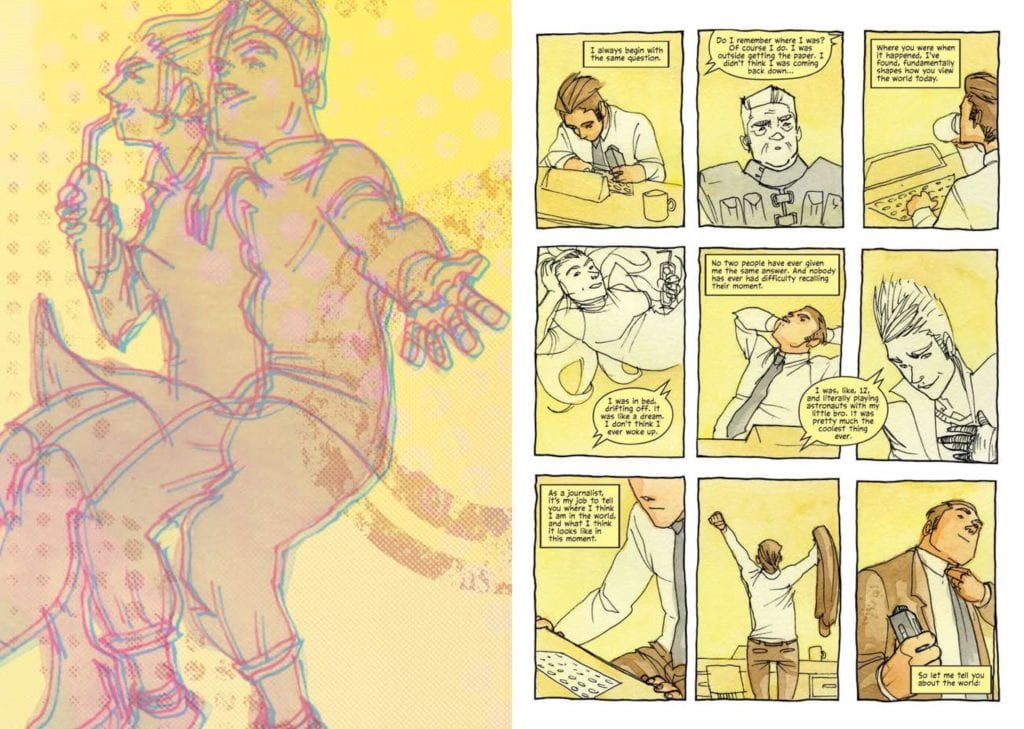
Nick Tapalansky And Kate Glasheen Interview
Even though it’s science fiction, A Radical Shift of Gravity hits home because of the massive changes happening around the world. What are some challenges and fears we might share with the main characters, Noah and Elycia?
Nick: Boy, where to start? We initially set out to tell a story about a family experiencing some pretty normal challenges set against a fantastic world. We wound up with a book that was far more timely (for better and for worse) and relatable than we maybe could have imagined.
Concerns about global crises, from COVID-19 to global warming, certainly come to mind first. How do we adapt to these changes? Is there any good to be done, or any harm we can stave off, delay, or prevent entirely? Is it safe to step outside, go to the supermarket, do the things I took for granted three months ago?
Then you throw in the family dynamic: how do I raise a toddler/tween/teen in this world? How do I keep them safe and make sure they have an opportunity to grow and explore and change without putting themselves very literally in harm’s way? And as that child, how do I find my way in the only world I’ve ever known when I’m not the least bit frightened of it, but the people closest to me may have strong feelings to the contrary?
Kate: It’s worth noting that Nick and his wife Jackie had a baby almost immediately after we signed with Top Shelf, so Nick got to draw from 100% authentic parental terror for inspiration during development.
Nick: It’s true! And that general dynamic and fear is a perennial concern, no matter the state of the world. But when we set out to tell this story, I think we thought creating such a fantastic, fable-like global change would seem far more foreign and metaphorical than it does in 2020.
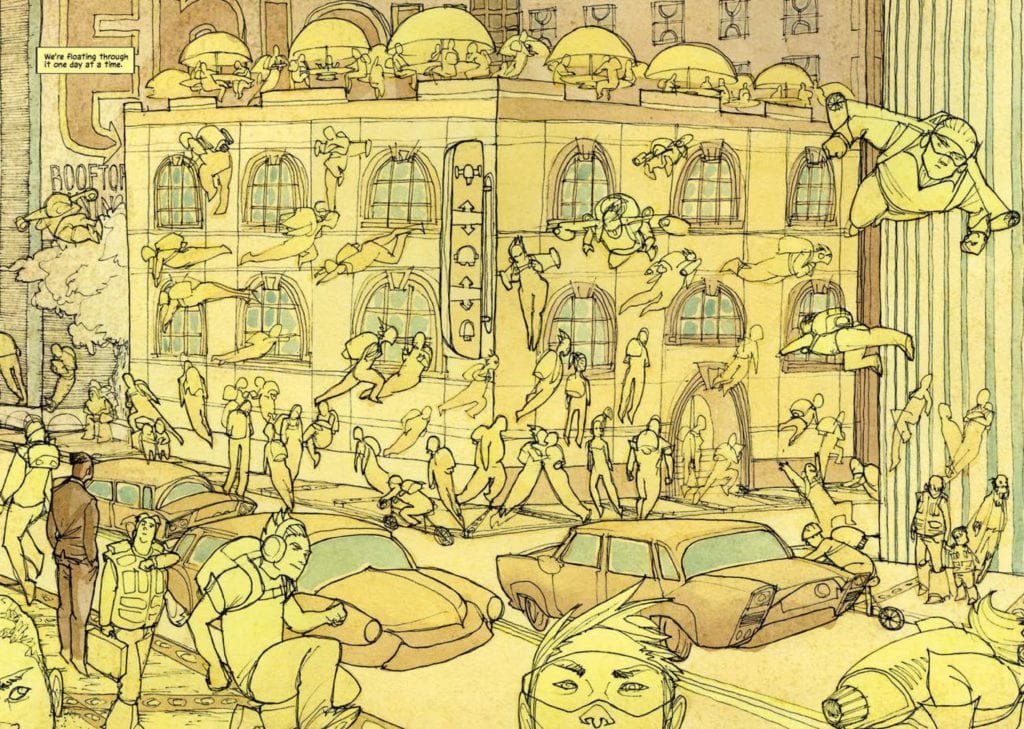
What inspired you to tell this story from multiple points in time, and how did you pull off that tricky structure?
Nick: A lot of false starts trying to approach it as a linear narrative, haha! Putting it all into an order that worked involved a very complicated spreadsheet and lots of color coding.
It’s pretty much always been split up into multiple points in time, but thinking about them going directly from start to finish never sat right with me. When I finally committed to splitting things up I still wrote them each as individual segments, but knowing I was going to weave them together made that process more fun for me. After they were all written I broke out each scene and then started thinking about them as individual components, looking for break points in each era and finding commonalities between scenes so that the transition wouldn’t feel entirely random.
Kate’s stellar work in creating distinct palette’s and visual motifs for each era did a lot of heavy lifting to keep readers from being unbearably disoriented in these transitions, though I think we both were hoping the transitions would keep folks just a little unmoored while following along.
Kate: Each era represents a different popular attitude towards the shifts as well, and I tried to support that in my choice of colors. For example, the opening era, The Golden Age, is right after the first shift. Gravity is less powerful, but not in a hugely life altering way, so people are really embracing the novelty of it. It’s a whimsical time, it’s fun, new products are being rushed out that focus on the enjoyment of the lessened gravity, new sports are invented to be played on multiple planes. It’s almost hedonistic— we modeled it after the roaring twenties philosophically and the Art Deco movement visually. So the base color for The Golden Age is a yellow gold color both for the literal component, and to capture a symbolic joy and a glitz and glamour.
A second example of that is in the chronologically final era we refer to as The Last Journalist on Earth. Noah’s alone on the planet (aside from a few stubborn planetary squatters) and gravity’s just gone completely. He spends these days undertaking his final assignment and reporting on the state of the planet. Nick and I decided at some point that gravity was like an ocean, and though gravity is gone at this point, its presence is most notable in its absence. So I used a soft blue color to represent and to represent the loneliness of Noah’s current journey, despite it not being a sort of pleasant one for him, but also act as this omnipotent ocean voice that we wanted gravity to have.
Nick: There’s a general sense of the Earth reclaiming itself sneaks in throughout the eras and creates some unique visual opportunities. Narratively it could be considered part of the inexplicable situation humanity finds itself in, but the interpretation is up to the reader. The natural reason being that people were hiding inside and not maintaining infrastructure, and weren’t polluting, and the planet responded by thriving in an almost aggressive way. But also, the idea that the world was just done with humanity and kicking us out using every tool at its disposal is on the table.
In either case, it was another element that Kate was able to leverage to showcase changes, both in the presence of this encroaching growth and how its presence impacts color, layout, and action. It’s most present in a segment of the book we think of as The Reclamation, where Noah and Elycia visit a community trying to recreate life on Earth prior to the shifts. Lush forestry and plant life spills across pages and panels, making its presence inescapable for the reader, and the characters.
Kate: Right. The base color for The Reclamation is green, to reinforce nature’s exponential take-back. I also love that the title, “Reclamation,” is as much a question as a descriptor. What’s being reclaimed, and who’s doing the reclaiming? The Grounded Community, and their old way of life? Or nature, and a much, much older way of life?
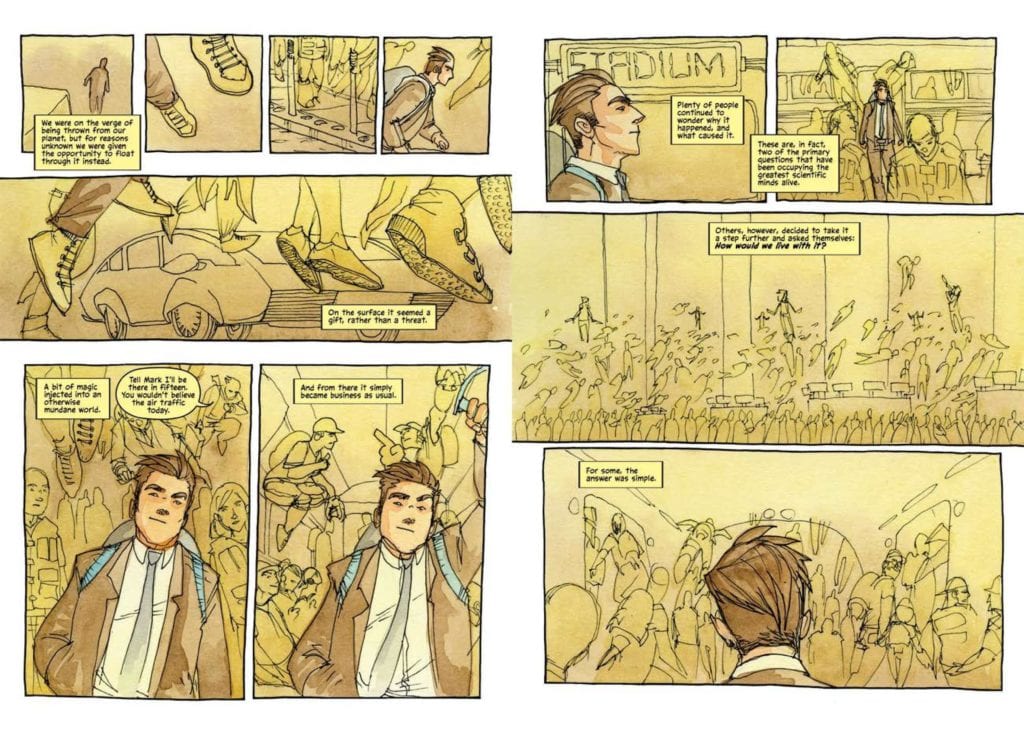
The page layouts in this book vary quite a lot: from traditional grid structures to double-splash-pages to triangles, circles, and even more unconventional shapes. How do those layouts help tell the story, and how do you decide the look of any given page?
Kate: To live through each era is a markedly different experience from the one before or after. It was easy for me to picture the old man who lived through all of them, tethered to his front porch, lamenting the bygone days of joyfully rocketing to the big game while his family was floating off the planet completely, right in front of him. I wanted the reader to be able to empathize with the crotchety old gravity man, or at least feel for him for living a life that got him to that place. Gravity, the force behind the fable of our book— also affects how people experience time. When it functions as we know it in reality, time is linear. As gravity ebbs and flows, and eventually disappears altogether, that experience becomes more jumbled, more contemporaneous. We wanted that surreality of time to extend beyond the fourth wall, to also affect the reader.
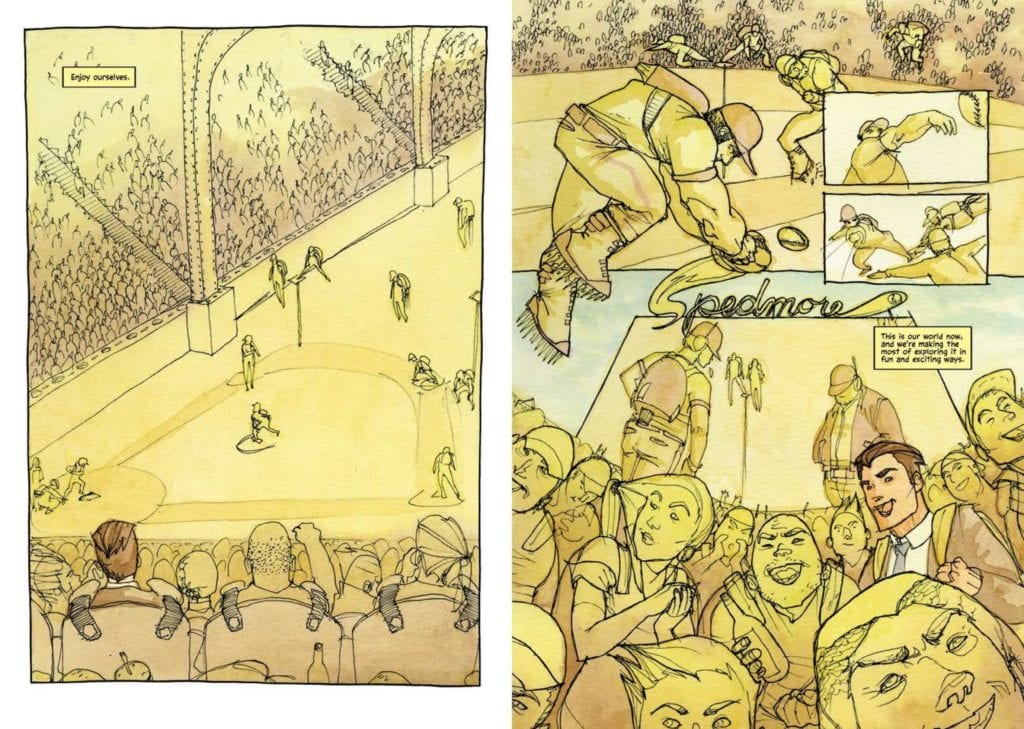
In the Golden Age pages, I tried to keep the layouts more ordered, more straightforward, and relatively traditional, in panel placement and flow since it largely resembles our way of life and experience of time. Then if you jump to The Last Journalist on Earth, I wanted each page to feel untethered by the rules of gravity and the rules of comics. I wanted to reflect Gravity’s abandonment of Earth through panels floating off of the top of the page, or hanging in the gutter space in unorthodox ways.
Another example of this occurs in The Last Journalist on Earth. There’s one page where Noah is gathering ingredients for a meal. Since the order of events isn’t important in this moment—it doesn’t matter if Noah grabs parsley before basil in the way it would matter between two characters conversing— I wanted to use this opportunity to mess with chronology of information delivery. I collapsed the time of this moment by trying to display these four panels in a way that the eye would read them almost simultaneously, or at least in a way that was different from the expected left to right, top to bottom, reading order. Or, at least, that’s what I was trying to do and I hope I did it.
What are your thoughts on the interview? Do you plan on picking up a copy of A Radical Shift of Gravity? Comment below with your thoughts.
